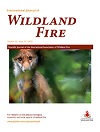
International Journal of Wildland Fire
Volume 32 Number 10 2023
WF23023Can predators influence small rodent foraging activity rates immediately after wildfires?
Rodents strategically adjust their activity levels to minimise encounters with predators and find safe habitats, selecting those structurally complex with shelters. After fire, intraspecific competition also affects foraging. These results highlight the complex interaction between habitat structure, predation risk and rodent activity levels in post-fire ecosystems, providing insights into the dynamics of their adaptive behavior.
WF23023 Abstract | WF23023 Full Text | WF23023PDF (1.4 MB) | WF23023Supplementary Material (1.1 MB) Open Access Article
WF23007Quantifying the flammability of living plants at the branch scale: which metrics to use?
We provide a pathway towards more consistency in plant flammability research by identifying a subset of preferred flammability metrics for live plant specimens. Future studies that incorporate these metrics will be more comparable, helping to facilitate a broader understanding of plant flammability.
WF23007 Abstract | WF23007 Full Text | WF23007PDF (3.7 MB) Open Access Article
WF22219Extending methods for assessing fuel hazard in temperate Australia to enhance data quality and consistency
We developed a repeatable method for assessing fuel in forests, woodlands and shrublands that extended an existing Australian method. Fuel properties and hazard differed between the two methods. The extended method took longer but offered advantages including improved scope for data integration with emerging fuel-measurement techniques and multi-value vegetation assessments.
WF22219 Abstract | WF22219 Full Text | WF22219PDF (4.2 MB) | WF22219Supplementary Material (5 KB) Open Access Article
WF22227Transitioning operational satellite grassland curing from MODIS to VIIRS
In Australia, MODIS-based grassland curing (senescence) data have fed into fire danger calculations since 2013. MODIS has exceeded its designed lifespan, so the grassland curing model has transitioned to VIIRS. The VIIRS curing model was handed over to the Bureau of Meteorology for continued daily input into fire danger calculations.
WF22227 Abstract | WF22227 Full Text | WF22227PDF (3.5 MB) Open Access Article
WF23074Improved logistic models of crown fire probability in Canadian conifer forests
 , Miguel G. Cruz
, Miguel G. Cruz  , Martin E. Alexander, Chelene C. Hanes, Dan K. Thompson, Stephen W. Taylor and Brian J. Stocks
, Martin E. Alexander, Chelene C. Hanes, Dan K. Thompson, Stephen W. Taylor and Brian J. Stocks
Updated statistical models are presented for predicting conifer crown fire occurrence based on weather and fuel structure data from experimental burning studies across Canada. The new models are more flexible than previously published ones and are based on ~50% more observations. They should be useful for operational forecasting and other purposes.
WF23074 Abstract | WF23074 Full Text | WF23074PDF (3.7 MB) | WF23074Supplementary Material (1.3 MB) Open Access Article
WF23036Measuring the long-term costs of uncharacteristic wildfire: a case study of the 2010 Schultz Fire in Northern Arizona
 , Melanie M. Colavito
, Melanie M. Colavito  , Catrin M. Edgeley, Jack T. Burnett, Thomas Combrink, Diane Vosick and Andrew Sánchez Meador
, Catrin M. Edgeley, Jack T. Burnett, Thomas Combrink, Diane Vosick and Andrew Sánchez Meador
Costs of wildfire accrue for many years across several categories but are rarely documented in full. In this study, we measured the long-term costs of uncharacteristic wildfire by estimating fire damages in terms of government and utility costs, household costs and ecosystem service costs.
WF23036 Abstract | WF23036 Full Text | WF23036PDF (1.4 MB) Open Access Article



